refuelling Citroen DS4 RHD 2011.5 1.G Owner's Manual
[x] Cancel search | Manufacturer: CITROEN, Model Year: 2011.5, Model line: DS4 RHD, Model: Citroen DS4 RHD 2011.5 1.GPages: 396, PDF Size: 12.14 MB
Page 33 of 396
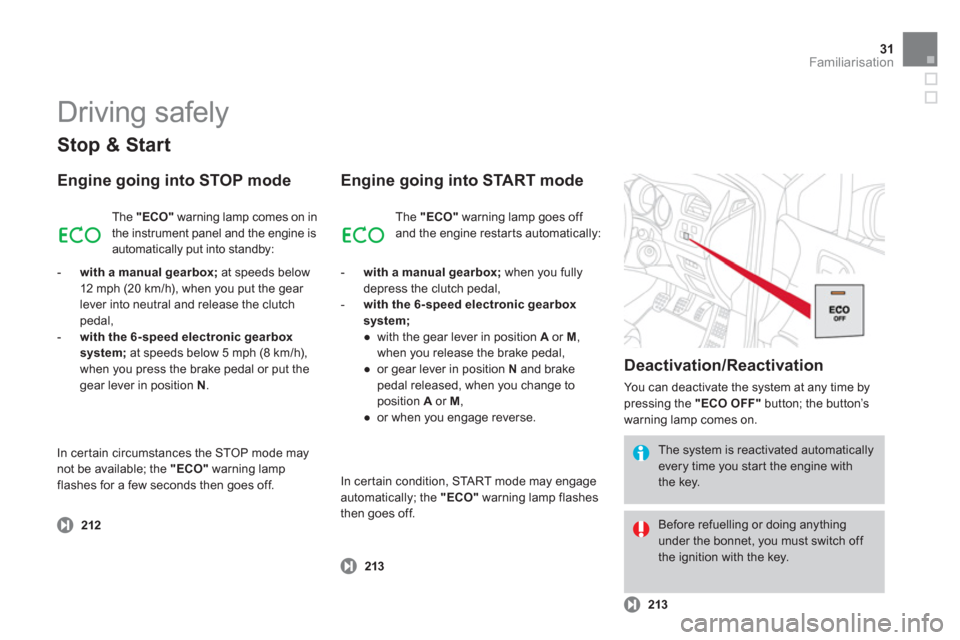
31Familiarisation
Stop & Start
Engine going into STOP mode
212Th
e "ECO"warning lamp comes on in
the instrument panel and the engine is automatically put into standby:
- with a manual
gearbox;
at speeds below
12 mph (20 km/h), when you put the gear
lever into neutral and release the clutchpedal, -with the 6-speed electronic gearbox
system;at speeds below 5 mph (8 km/h),
when you press the brake pedal or put the
gear lever in position N.
Engine going into START mode
Deactivation/Reactivation
You can deactivate the system at any time bypressing the "ECO OFF"
button; the button’s
warning lamp comes on.
213
213
The system is reactivated automatically every time you start the engine withthe key.
Before refuelling or doing anything under the bonnet, you must switch off the ignition with the key. Th
e "ECO"
warning lamp goes off
and the engine restarts automatically:
-
with a manual gearbox;when you fullydepress the clutch pedal, -
with the 6-speed electronic gearboxsystem;
●
with the gear lever in position A
or M ,
when you release the brake pedal,
●
or gear lever in position N
and brake
pedal released, when you change to
position
Aor M ,
●
or when you engage reverse.
In certain circumstances the ST
OP mode may not be available; the "ECO"warning lamp
flashes for a few seconds then goes off.In certain condition, START mode may engageautomatically; the "ECO"
warning lamp flashes
then goes off.
Driving safely
Page 37 of 396
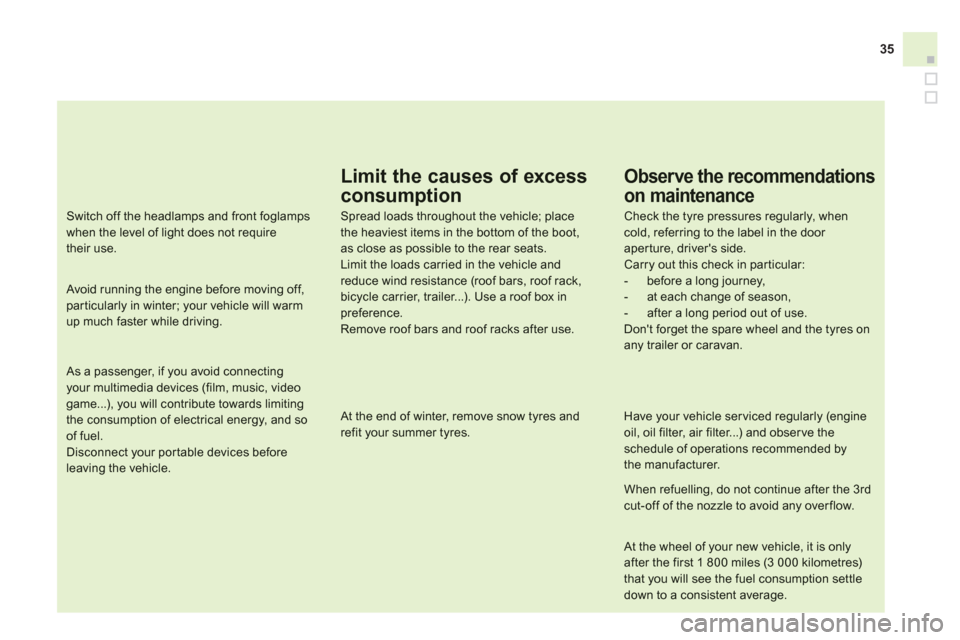
35
Limit the causes of excess
consumption
Spread loads throughout the vehicle; placethe heaviest items in the bottom of the boot, as close as possible to the rear seats. Limit the loads carried in the vehicle andreduce wind resistance (roof bars, roof rack,bicycle carrier, trailer...). Use a roof box in preference. Remove roof bars and roof racks after use.
At the end of winter, remove snow tyres andrefit your summer tyres.
Observe the recommendations
on maintenance
Check the tyre pressures regularly, whencold, referring to the label in the door aperture, driver's side.
Carry out this check in par ticular:
- before a long journey,
- at each change of season,
- after a long period out of use.
Don't forget the spare wheel and the tyres on any trailer or caravan.
Have your vehicle ser viced regularly (engineoil, oil filter, air filter...) and obser ve theschedule of operations recommended bythe manufacturer.
When refuelling, do not continue after the 3 rdcut-off of the nozzle to avoid any overflow.
At the wheel of your new vehicle, it is only after the first 1 800 miles (3 000 kilometres) that you will see the fuel consumption settledown to a consistent average.
Switch off the headlamps and front foglamps when the level of light does not require their use.
Avoid running the engine before moving off,particularly in winter; your vehicle will warmup much faster while driving.
As a passenger, if you avoid connecting your multimedia devices (film, music, videogame...), you will contribute towards limitingthe consumption of electrical energy, and soof fuel. Disconnect your por table devices beforeleaving the vehicle.
Page 120 of 396
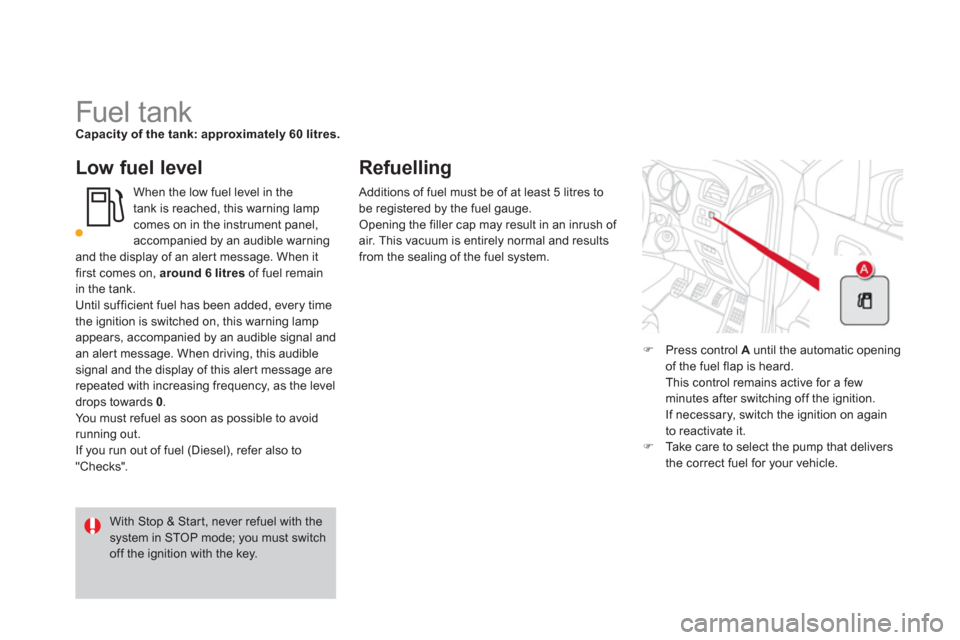
Fuel tank Capacity of the tank: approximately 60 litres.
Low fuel level
When the low fuel level in the
tank is reached, this warning lamp comes on in the instrument panel,
accompanied by an audible warning and the display of an aler t message. When it first comes on, around 6 litres of fuel remain
in the tank.
Until sufficient fuel has been added, every time
the ignition is switched on, this warning lampappears, accompanied by an audible signal and an aler t message. When driving, this audiblesignal and the display of this aler t message are repeated with increasing frequency, as the level
drops towards 0 .
You must refuel as soon as possible to avoid
running out.
If you run out of fuel (Diesel), refer also to
"Checks".
Refuelling
�)Press control A
until the automatic openingof the fuel flap is heard.
This control remains active for a few
minutes after switching off the ignition.
If necessary, switch the ignition on again
to reactivate it.�)Take care to select the pump that delivers
the correct fuel for your vehicle.
With Stop & Star t, never refuel with the system in STOP mode; you must switch off the ignition with the key. Additions of fuel must be of at least
5 litres to be registered by the fuel gauge.
Opening the filler cap may result in an inrush of
air. This vacuum is entirely normal and results from the sealing of the fuel system.
Page 121 of 396
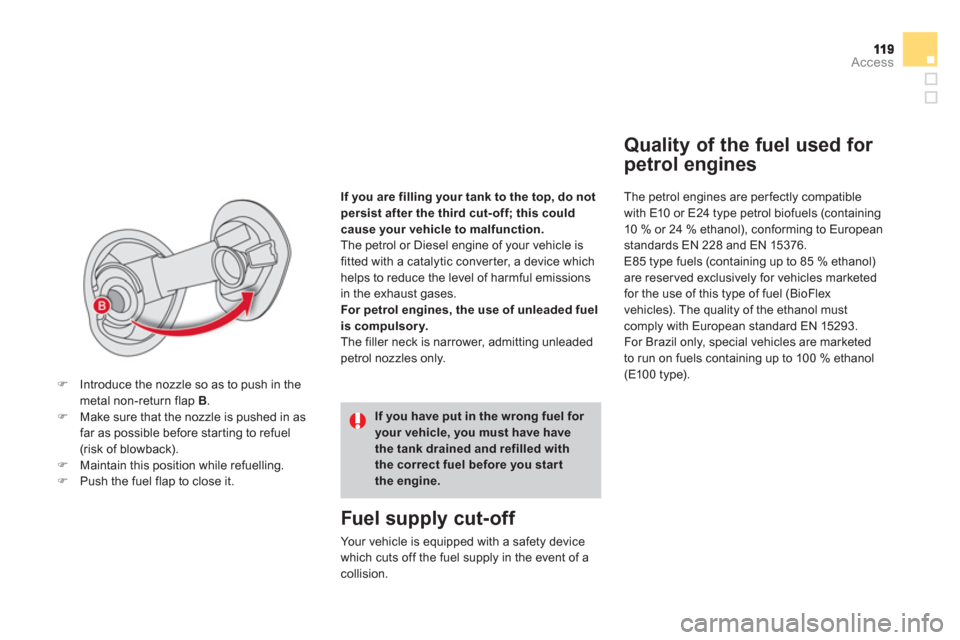
Access
Quality of the fuel used for
petrol engines
The petrol engines are perfectly compatible
with E10 or E24 type petrol biofuels (containing
10 % or 24 % ethanol), conforming to European standards EN 228 and EN 15376.
E85 type fuels (containing up to 85 % ethanol)are reser ved exclusively for vehicles marketed for the use of this type of fuel (BioFlex
vehicles). The quality of the ethanol must comply with European standard EN 15293.
For Brazil only, special vehicles are marketed
to run on fuels containing up to 100 % ethanol(E10 0 type).
If
you are filling your tank to the top, do notpersist after the third cut- off; this could cause your vehicle to malfunction.The petrol or Diesel engine of your vehicle isfitted with a catalytic conver ter, a device which helps to reduce the level of harmful emissionsin the exhaust gases.
For petrol engines, the use of unleaded fuelis compulsory.The filler neck is narrower, admitting unleadedpetrol nozzles only.
Fuel supply cut-off
Your vehicle is equipped with a safety device which cuts off the fuel supply in the event of acollision.
If you have put in the wrong fuel for your vehicle, you must have have the tank drained and refilled withthe correct fuel before you startthe engine.
�)Introduce the nozzle so as to push in themetal non-return flap B.
�)Make sure that the nozzle is pushed in as
far as possible before star ting to refuel(risk of blowback).�)Maintain this position while refuelling.�)Push the fuel flap to close it.
Page 123 of 396
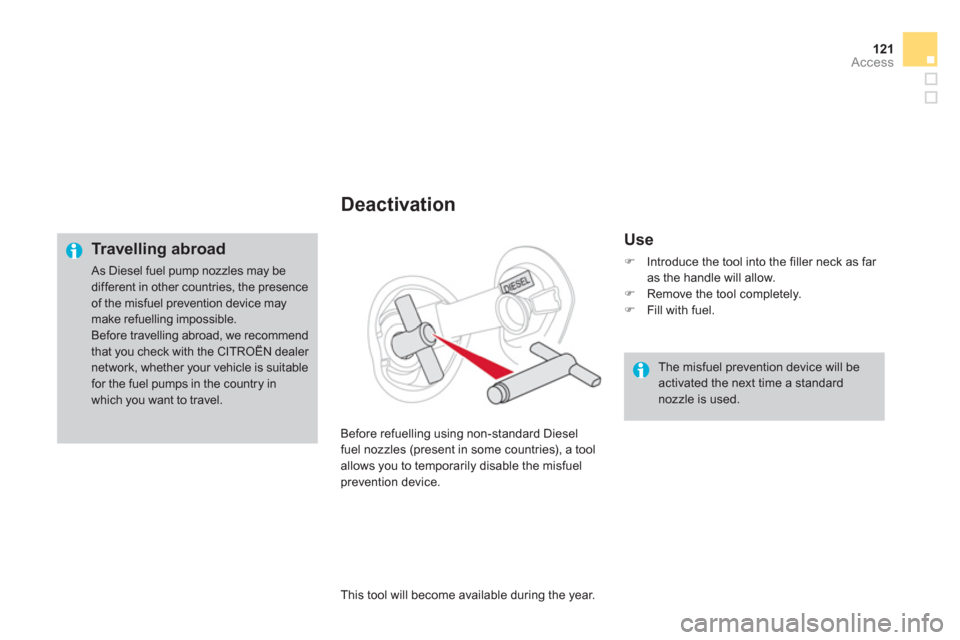
121Access
Deactivation
Use
�)
Introduce the tool into the filler neck as far as the handle will allow.�)
Remove the tool completely.�)
Fill with fuel.
Before refuellin
g using non-standard Diesel
fuel nozzles (present in some countries), a tool allows you to temporarily disable the misfuelprevention device.
The misfuel prevention device will beactivated the next time a standard nozzle is used.
This tool will become available durin
g the year.
Tr a v e l l i ng abroad
As Diesel fuel pump nozzles may be different in other countries, the presence of the misfuel prevention device maymake refuelling impossible.
Before travelling abroad, we recommend that you check with the CITROËN dealer network, whether your vehicle is suitablefor the fuel pumps in the country in which you want to travel.